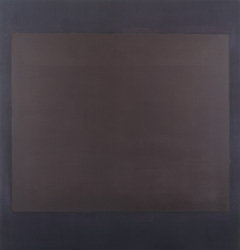Mark Rothko
dal 20/2/2010 al 1/1/2011
Segnalato da
20/2/2010
Mark Rothko
National Gallery of Art, Washington
In the Tower. The second in a series of exhibitions focusing on contemporary art and its roots offers a rare look at the black-on-black paintings that Rothko made in 1964 in connection with his work on a chapel for the Menil Collection in Houston. A recording of Morton Feldman's Rothko Chapel (1971), the haunting music originally composed for that space, accompanies the exhibition in the serene East Building Tower Gallery. A new 10-minute film examines the career of Rothko and his development of a style that fused abstract painting with emotional significance. Curated by Harry Cooper.

Curated by Harry Cooper, curator, modern and contemporary art, National Gallery of Art
The second in a series of exhibitions focusing on contemporary art and its roots offers a rare look at the black-on-black paintings that Rothko made in 1964 in connection with his work on a chapel for the Menil Collection in Houston. A recording of Morton Feldman's Rothko Chapel (1971), the haunting music originally composed for that space, accompanies the exhibition in the serene East Building Tower Gallery.
Mark Rothko was born Marcus Rothkowitz in Dvinsk, Russia, on September 25, 1903. His parents were Jacob and Anna Goldin Rothkowitz, and Rothko was raised in a well-educated family with Zionist leanings. At the age of ten, Rothko and his mother and sister immigrated to America to join his father and brothers, who had previously settled in Portland, Oregon. From 1921 to 1923 Rothko attended Yale University on a full scholarship and then moved to New York City. In 1924 he enrolled in the Art Students League, studying with George Bridgman and Max Weber, in whose class he befriended Louis Harris. In 1929 Rothko began teaching children at the Center Academy of the Brooklyn Jewish Center, a position he retained for more than twenty years.
He was given his first one-man exhibition in 1933 at the Museum of Art in Portland and his first in New York a few months later at the Contemporary Arts Gallery. The New York exhibition included landscapes, nudes, portraits, and city scenes. At the end of 1934 Rothko particiated in an exhibition at the Gallery Secession, whose members inluded Louis Harris, Adolph Gottlieb, Ilya Bolotowsky and Joseph Solman; several months later they left the Secession to form their own group, the Ten, which exhibited together eight times between 1935 and 1939. Rothko's paintings in the Ten's exhibitions were expressionist in style. During this period he was employed by the WPA (Works Progress Administration), where he produced many subway scenes emphasizing the isolation of the riders.
From the later 1930s to 1946 Rothko's oil and watercolor paintings reflected his interest in Greek mythology, primitive art, and Christian tragedy. Influenced by the Surrealists Miró and André Masson, among others, he explored the technique of automatic drawing in creating abstract, diaphanous forms that allude to human and animal life. In 1940, Rothko, along with his colleagues Gottlieb, Bolotowsky, and Harris, broke with the American Artists' Congress on political grounds and became founding members of the Federation of Modern Painters and Sculptors. He was given, in 1945, a one-man exhibition at Peggy Guggenheim's gallery Art of This Century, which featured his surrealist works. At the end of the year he was included in the Whitney Museum of America Art's Annual Exhibition of Contemporary American Painting. In 1948 he joined William Baziotes, David Hare, and Robert Motherwell in founding an art school, the Subjects of the Artist, which closed within a year.
By 1947 Rothko had eliminated all elements of surrealism or mythic imagery from his works, and nonobjective compositions of indeterminate shapes emerged. Within three years he reached his signature format, painting two or three soft-edged, luminescent rectangles, stacked weightlessly on top of one another, floating horizontally against a ground. Now a recognized artist of the New York School, he was given, in 1954, a one-man exhibition by the Art Institute of Chicago. In 1958 Rothko accepted his first commission for a series of paintings for the Four Seasons restaurant. He received his second commission for murals in 1961 for the Holyoke Center at Harvard University. From 1964 to 1967 Rothko worked on his third and last commission, a Roman Catholic chapel in Houston, now interdenominational, creating fourteen canvases, numerically corresponding to the Stations of the Cross. From 1968 on, he worked in acrylic on canvas and paper, reducing his palette to brown, gray, and black.
Rothko was elected to the National Institute of Arts and Letters in 1968. The following year Yale University awarded him an honorary Doctor of Fine Arts degree. In 1970 Rothko committed suicide in his studio. (Painting a Place in America: Jewish Artists in New York 1900-1945, see References/Literature)
Film: A new 10-minute film examines the career of Rothko and his development of a style that fused abstract painting with emotional significance. Produced by the National Gallery of Art, the film will be shown continuously in the Tower Gallery. The film was made possible by the HRH Foundation.
The exhibition is made possible by the generous support of the Aaron I. Fleischman Foundation.
Image: Untitled, 1964, oil and mixed media on canvas. Gift of The Mark Rothko Foundation, Inc. Copyright © 1997 Christopher Rothko and Kate Rothko Prizel
Chief Press Officer Deborah Ziska
(202) 842-6353 ds-ziska@nga.gov
Opening 21 February 2010 at 11
National Gallery of Art
4th Street and Constitution Avenue, Washington
open Monday through Saturday from 10:00 a.m. to 5:00 p.m.
and Sunday from 11:00 a.m. to 6:00 p.m.
closed on December 25 and January 1.
Admission is free



